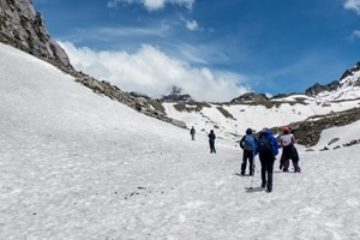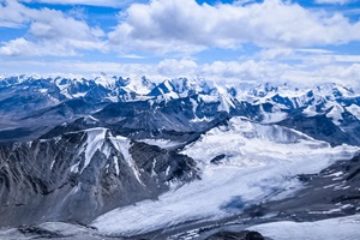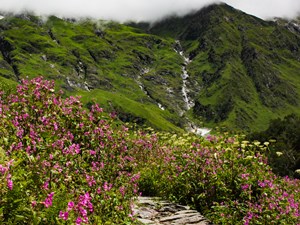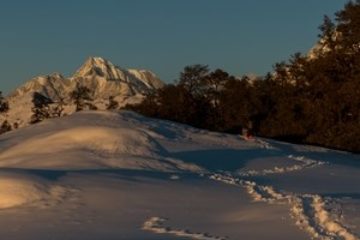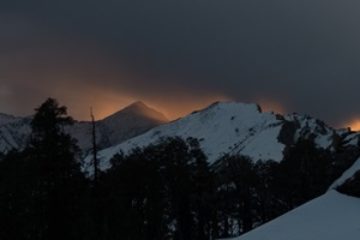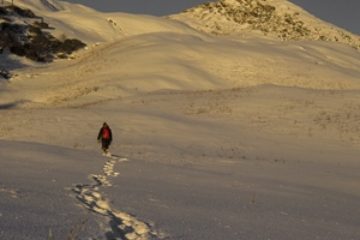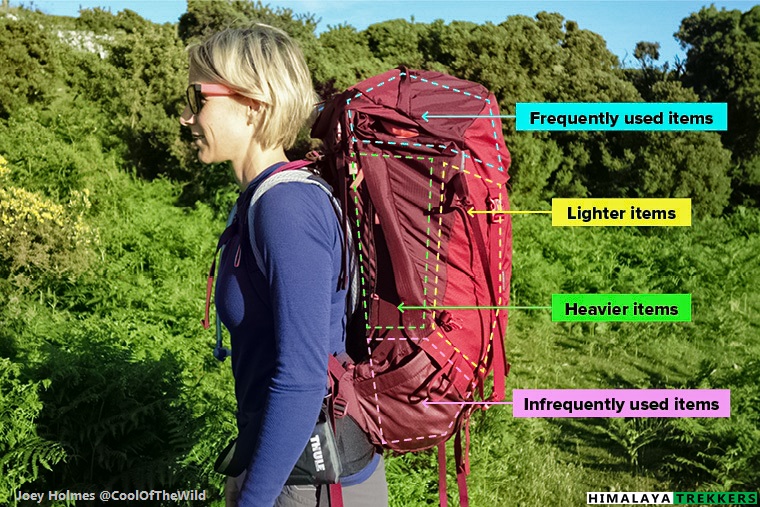
How you should pack your rucksack during a trek
Packing a rucksack or a backpack correctly is indeed a very important aspect of any trip or trek. A well packed backpack ensures maximal comfort as well as easy access to frequently used items.
In the ideal world, all your gear would be as lightweight as possible. But even ultra lightweight gear adds up — especially on long distance treks in the Himalayas.
The treks on the different parts on the Himalayas stretch from short and medium to extended long duration. Shorter duration trek backpacking is easier but for medium to long duration you need to pack with more attention. Higher the duration of the trek, higher the importance. The catch is to pack light all the necessary and safety items with carrying comfort.
You will achieve the above if you know:
- The items/gears to carry in your backpack
- Organisation of the items inside your backpack
Now let us get into the details of the above aspects:
The items/gears to carry in your backpack:
Essentially a trekking Rucksack/Backpack on the Himalayas will contain.
- Clothing
- Windproof/Waterproof/Rain gear
- Sleeping Bag
- Accessories
- First-Aid cum medicine kit
- Dry food to sustain a day in emergency condition
For the detailed checklist read what are the things that you need to carry in your backpack while trekking.
Oh wait! Every gram on the mountain matters. Quality light weight products are often expensive. These are designed to meet standards on harsh climate. We would assert you to acquire/buy such clothing/equipment one by one, if not all together. Read how to choose your trekking gear and equipment before you get these.
Here we would focus on how to pack everything in a backpack while not compromising your own safety. There are round trek trails where you get an option to shed some weight, leaving a luggage at the base camp. While returning you can pick the left luggage. In certain popular and safer routes you have the possibility to offload the rucksack on a mule (in such case you carry a light day pack with you for must to have items) or even to a porter. But crossing a pass or most of the longer duration trek will require packing everything in one Rucksack and carry along all through. A medium duration trek can involve 4-7 trekking days and longer duration ranges between 8 to 12 trekking days.
A mid to long duration trekking Rucksack should weigh between 8 to 12 Kg. Being a trekker you should grow the habit to carry it comfortably. This also ensures that you leave less footprint on mountain.
In a Difficult/Hard/Challenging trek you should always carry the following items for your own safety. In fact we strongly discourage “offloading” of backpack in “Difficult” grade treks.
1) Warm Jacket 2) Waterproof plus Windproof gear 3) Sleeping bag + carry mattress 4) Emergency dry food items
The first step is to select a proper Rucksack ,as per your trip or trek. Don’t by an unnecessary large spacious backpack, or a too small one. For a medium to long duration treks, it is sufficient to use a Rucksack/Backpack between 40 to 60 Litre. In general a 50 L rucksack should have enough space inside to pack everything including your sleeping bag for a trek up to 2 weeks. One such bag should weigh within 1.5 Kg.
Clothing: Always use synthetic quick dry t-shirts. Cotton tees are heavy and take time to get dried. 4/5 t-shirts are good enough for a home to home round trip. For lower use again the synthetic light weight/quick dry trousers. 2/3 such trousers are good. Don’t carry your jeans unless there is an option to leave luggage at base camp. A Cargo/Six-pocket can be used instead. Together upper and lower wear should not weigh more than 2 Kg.
Innerwear, socks, cap, balaclava, gloves are lighter items and should be within 500g.
For a high altitude trek an upper thermal base layer (Woolycot) is essential. The lower one is optional. Normally protection is vital for upper portion of the body. Adds another 500g to your back.
Warm jackets are of different types and varying weight. Normally a Fleece/Synthetic Fill/Down jacket is light and provides adequate warmth. The weight should be within a Kilogram for such a jacket.
A windproof upper with hood is also a must item. Normally these will have water repellent property. A typical Raincoat/Poncho is not recommended as these are heavy and not breathable, unless you are trekking in monsoon.
Sleeping Bag: For a Himalayan trek Sleeping bags are rated with a temperature rating between -10 Deg C to 0 Deg C. For lower temperatures you can use one additional base layer inside while sleeping. Synthetic/Down filled sleeping bags weigh up to 2Kg.
Accessories: You have to be careful to select what to take and what to discard. My approach is being minimalist to choose from a wide range of items. A tooth paste (Small tube of Rs 10), toothbrush, tissue roll, a Boroline/chapstick, a scissor, (or a light weight multi tool), a torch, soap strip and a small container of cold cream are good for the purpose. Maybe a small deo-spray on top of these. No need for a shaving or any beautification kit. Should not weigh more than 500g.
First-Aid/Medical Kit: A crepe bandage, cotton, Dettol/Savlon, antiseptic creme, a course for each including headache, vomiting, anti-inflammatory, pain killer, and stomach upset, Volini spray. Together all these weigh again maximum of 500g.
Keep some dry instant edible food items for emergency. A pack of candy, few chocolate bars/energy bars, dry fruit mix and a small pack of Glucon C/D/Gatorade. Another 500g.
Wait, we are not done yet! A bottle of water is must. Ask the guide clearly whether you will be able to refill the bottle on the trail or not. On a log day you may need to carry 2 L of water where you don’t come across a drinking water source. Weighs additional 1 to 2 Kg.
Adding up the items, total weight remains around 12 Kg (including the sleeping bag and the Rucksack)
Here is an example how Saptarshi Roy (the founder of HT) packs for his Himalayan high altitude treks.
Rucksack: Camp M4 – 40 L – 1 Kg
T-Shirts, trek pants, inner wear, socks, caps, gloves etc.: ~ 2 Kg
Warm Jacket: Mountain Hardware Windstopper Tech Fleece ~ 650g
Windproof/Waterproof: Marmot Precip Jacket ~ 370 g
Sleeping Bag: Mountain Hardware Ultralamina 15 Deg F ~ 1.3 Kg
Accessories and Medical Kit: ~ 1 Kg
Water: Hydration pack/bottle of 1.5/2 L ~ 2 Kg
Miscellaneous: Notebook, pen, GPS, Binocular etc ~ 1 Kg
Camera: Panasonic Lumix DMC FZ200 with additional batteries ~ 1 Kg
Adding all it 10 Kg and this is how it looks after packing.
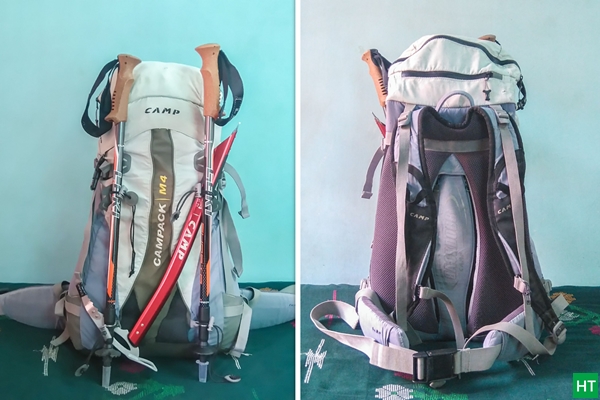
Organisation of the items inside your backpack:
Once you know what to pack, arranging these into an order becomes important.
Place items in your bag correctly that heavier items are kept close to your body, making the load more bearable and comfortable.
Packing with thought also ensures that you have easy access to certain items during your hiking hours. light snacks/chocolates, personal items, water, and waterproofs should all be easily accessible without having to delve right into your backpack. Other, less frequently used items should be packed deeper inside the pack.
Sleeping bag should go in the bottom, as you don’t need it before campsite. This gives stability to the Rucksack. A well packed Rucksack would stand straight on the ground without a support. Pack similar items together. Its easier to carry a backpack when the load is evenly distributed.
Weather on the mountain often surprises us. A rain/hail/snow/flakes are common on the mountains depending upon which season you choose. Use a waterproof Rucksack cover/Rain fly. Your jacket and sleeping bag must not get wet in any condition. For double protection use an inner liner of polythene sheet or pack your items inside polypacks. Even if your Rucksack is wet from outside, this layer/plastic cover will make sure that your essential items are dry and toasty.
We hope that now you are confident about what and how to pack for a trekking trip to the Himalayas.
To finish, we would say that backpacking is an art and pack rationally.
Happy packing 😎
Team HT
Upcoming treks and expeditions
Check out this video



